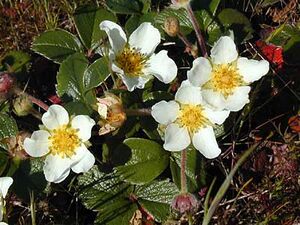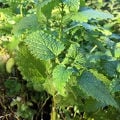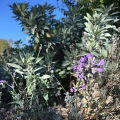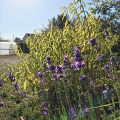
Encircled by the Gathering Room and the main offices at Potawot, the Wellness Garden (Header[1]) is filled with various native plants from the Northwestern region of the U.S.W These plants are used to educate the patients at Potawot about traditional plants and herbs used in healing. These species tend to be easy to grow and maintain so as to promote self-sustainability within the community. Potawot Health Village's visitors can come to learn about the medicinal and nutritional uses of these plants, while also enjoying the serenity of nature and using it to aid in the rehabilitation process if needed. Some of the plants in the garden have a high nutritional value, but most are in place to simulate the environment in this part of California. The plants are all described in detail in the table below (Figures 2-13).[2]
The stream that runs through the Wellness Garden's 10,000 square feet contributes hugely to the native shrubs, flowers, trees and medicinal herbs that grow within it. The stream winds through the garden starting at the far end, traveling across the length, passing underneath and around the front of the building, and finally underneath the entry bridge. The stream then flows south into a pond where the re-circulation pumps send the water to begin the process again. This stream demonstrates another aspect of Northern California's diverse environment.[3]
Plant Life[edit | edit source]

| Common Name | Scientific Name | Uses | Habitat | Description | |
|---|---|---|---|---|---|
| Evergreen Huckleberry | Vaccinium Ovatum | Eaten commonly either fresh or dried, these berries were highly sought after by indigenous tribes of the Northwest. | Grows in both sunny and shady conditions, with above average amounts of water. However, the more sun this shrub gets the more berries it will produce, but it will not grow as tall as it would under shady conditions. | A small, round shrub that produces dark purple berries, which tend to be bitter. This form of Huckleberry shrub also produces little white, urn-shaped flowers that are utilized by butterflies, birds, and bees alike.[5] |  |
| Scouring Rush | Equisetum hyemale L. | The coarse cone on the tip of this horsetail was used to scrub dishware and floors. | Prefers full sun with wet conditions, such as a marsh. However, it has been known to proliferate at high rates, even when not in ideal conditions. | Scouring Rush plants are usually 2-4 feet tall, with their rough stems topped with spore bearing cones.[7] |  |
| Red Huckleberry | Vaccinium parvifolium Sm. | Indigenous people gathered the tart berries in baskets and ate them both fresh and dried, the leaves can also be brewed into tea and used as an effective cold remedy. | Generally found along edges of forests, these large shrubs prefer dry conditions for the most part with more shade than sun. | This Huckleberry shrub normally stands at four meters tall. The shrub has smooth bark on its branches with radiant green leaves. Small, oval leaves are complimented by a dense population of tiny red berries.[9] |  |
| Wormwood | Artemisia vulgaris L. | Wormwood has been known to treat various stomach issues ranging from a simple ache to an infected stomach. Has also been known to stimulate appetite. | Prefers shade and enough room so its roots can spread out. Grows easily in various climates. | This thick, coarse root grows up to three feet tall. Light green in color with fluffy white hairs covering it, Wormwood plants also produce small, greenish-yellow flowers.[11] |  |
| Toyon | Heteromeles M. Roem | This shrubs' berries are used to make a variety of different foods including: pancakes, wine, pudding, jelly, and tea. The berries were also used by indigenous tribes to make dyes for clothing. | Prefers full sun and open air flow, native in beach sand. | Toyon is a large shrub that grows from 7-10 feet tall. This plant produces vibrant white flowers in summer and edible red berries in winter.[13] |  |
| California Hazel | Corylus cornuta Marsh. var. californica (A. DC.) Sharp | An edible oil from California Hazel has been known to have been used by indigenous tribes. And the bark from this shrub can be used in fiber or cordage making. | This shrub flourishes in moist conditions with little shade. Generally most succesful in lightly wooded areas near bodies of water. | California Hazel is a deciduous shrub that can grow up to 30 feet tall. Its thin branches support only small, round light green leaves that fall in late April - early May.[15] |  |
| Beach Strawberry | Fragaria chiloensis (L.) Mill. | Red berries are very popular due to their particularly sweet taste. Used in various dishes. | Prefers much sun and water, does quite well with both but isn't near as productive without one of these mediums. | Described as a perennial forb or herb, Beach Strawberry plants have small oval leaves about 3 cm across, it produces white petaled flowers and sweet red berries in the spring and summer. This shrub tends to grow to about 1 foot in height. |  |
| Oregon Grape | Mahonia aquifolium | The fruit of this shrub has been long used for jelly, while the inside of its stems can be used to make a strong yellow dye. | Tolerates most all conditions, prefers a good amount of water but it can survive long droughts. | An evergreen shrub related to the barberry, this plant produces small dark-purple edible fruit.[18] |  |
| Douglas Iris | Iris douglasiana | Used mainly for gardening and landscape purposes. | This plant grows best near the coast, and cannot handle much else. Douglas Iris prefers rich soils such as clay and needs plenty of sun and water. | Classified as a perennial, Douglas iris grow a few feet tall in 3-4 meter wide clumps. Their purple and white flowers draw one's attention immediately.[20] |  |
| Vinetea (Yerba Buena) | Clinopodium douglasii (Benth.) Kuntze | Used to treat arthritis, head aches, tooth aches, intestinal relief, and indegestion. | Grows best in coastal regions with plenty of sun and rain. | An herb in the mint family, this aromatic plant has elongated leaves that produce small white or purple flowers.[22] |  |
| Coast Redwood | Sequoia sempervirens | Most notably used for paper and provides an excellent canopy to the forest. | Almost exclusive to coastal Northern California and Southern Oregon, this tree flourishes when humidity is high. It needs a lot of water but will grow best if water can drain away quickly from its' roots before rotting can occur. | These trees can become enormous, able to grow over 100 feet tall, with diameters that can become thicker than an average one lane road. Producing dark green needles, this thick skinned tree will surely outgrow its current place in Potawot.[24] |  |
| Silk tassel | Garrya Douglas ex Lindl. | Used in landscaping most prominently. | Grows best in dry coastal areas. Commonly used in landscaping due to its year-round beauty and easy manipulation of growth. | A common evergreen shrub to coastal CaliforniaW, silk tassel grows to between 2 and five meters. It produces soft tassel-like leaves and the ends of its normal leaves.[26] |  |
Update October 2014[edit | edit source]
This garden looks like it has not been given any yard work attention in the recent months. The architecture of the facility was well constructed giving the ability for native vegetation to thrive. All vegetation is native to the Northwest environment maintaining the original plan of sustaining native plant life. Vegetation expansion has over taken the facility. Signs of neglect in maintenance can be seen through out the garden. Plants have grown on top of one another and have invaded each other's territory. The stream looks like it inhabits a lot of algae. The position of the garden surrounded by the building allows for a visual sense of serenity. The environment built around this garden stimulates a comfortable environment for the patients and visitors of Potawot. The purpose of sustaining a well kept rehabilitation village still remains.
The original article that was published stated that the garden was, "easy to grow and maintain" the current status does not reflect the original intended goals. The original project's intentions were to educate the patients at Potawot of the traditional plants and herbs used in healing. The current status of the garden hinders the ability of education from observing the garden because of the lack of maintenance and educational signs. With out prior botany knowledge it would difficult to identify the species and benefits each individual plant holds. Adding signs to the garden can better educate visitors and the patients of Potawot. Giving a description of the major vegetation in the garden can add to the purpose and impact of this garden on it's community. Nearly all the vegetation that was listed on the site was not seen in the garden. This may be the case if certain vegetation is not in season.
Image 1. Wellness garden right side view
Image 2. Vertical vegetation growth
Image 3. View of stream- over grown of vegetation
Image 4. Wellness Garden Vegetation
Image 5. Algae growth. Plant diversity
Image 6. Wellness Garden Tree
Image 7. Close up of stream water quality
Image 8. Growth taking over territory
Image 9. Vine from the tree behind (not pictured) had grown through this tree.
http://www.slideshare.net/CharlotteSpassoff/potawot-wellness-and-food-garden
References[edit | edit source]
- ↑ picture courtesy of Eric Johnson
- ↑ "TCWF Final Grant Report", recieved from Eric Johnson on October 28, 2008.
- ↑ "TCWF Final Grant Report", received from Eric Johnson on October 28, 2008.
- ↑ "http://plants.usda.gov search bar", October 28, 2008.
- ↑ "Evergreen Huckleberry." Vaccinium ovatum. 2005. Accessed November 20,2008. http://web.archive.org/web/20120316092206/http://www.rainyside.com:80/features/plant_gallery/nativeplants/Vaccinium_ovatum.html
- ↑ "Evergreen Huckleberry, berries." Vaccinium ovatum. Taken 11/11/07. Accessed on November 26, 2008. http://www.flickr.com/photos/maximillian millipede/1971439565/
- ↑ "Grasses, Sedges, and non-flowering plants." Scouring Rush. 2005. Accessed November 20, 2008. http://www.illinoiswildflowers.info/grasses/plants/scouring_rush.htm
- ↑ "Equisetum." From Wikipedia, the free encyclopedia. 2008. Accessed November 24, 2008. http://en.wikipedia.org/wiki/Scouring rush
- ↑ "Evergreen Huckleberry." 2004. Accessed November 9, 2008. http://web.archive.org/web/20090416235619/http://www.ac.wwu.edu:80/~andybach/Ozette/NaturalHistory/Vegetation_links/huckleberries.html
- ↑ "red huckleberries." Flickr. 2008. Accessed December 9, 2008. http://www.flickr.com/photos/axiepics/188459997/
- ↑ "A Modern Herbal." Wormwood. 1995. Accessed November 21, 2008. http://www.botanical.com/botanical/mgmh/w/wormwo37.html
- ↑ "Artemisia absinthium." From Wikipedia, the free encyclopedia. 2008. Accessed December 11, 2008. http://en.wikipedia.org/wiki/Artemisia absinthium
- ↑ "Las Pilitas Nursery." Heteromeles arbutifolia. 2008. Accessed November 6, 2008. http://www.laspilitas.com/nature-of-california/plants/heteromeles-arbutifolia
- ↑ "IMGP0578." Flickr. 2008. Accessed December 10, 2008. http://www.flickr.com/photos/malvick/2418134124/
- ↑ "Plants For A Future: Database Search Results." Corylus Cornuta Californica. 1997-2000. Accessed on October 27, 2008. http://www.ibiblio.org/pfaf/cgi-bin/arr_html?Corylus+cornuta+californica
- ↑ "California Hazel." Flickr. 2008. Accessed November 15, 2008. http://www.flickr.com/photos/dreamsindigital/2841378733/
- ↑ "Fragaria chiloensis." From Wikipedia, the free encyclopedia. 2008. Accessed December 1, 2008. http://en.wikipedia.org/wiki/Beach strawberry
- ↑ "mahonia-aquifolium." 2008. Accessed November 4, 2008. http://www.laspilitas.com/nature-of-california/plants/mahonia-aquifolium
- ↑ "Oregon-grape." Flickr. Taken July 8, 2007. Accessed December 12, 2008. http://www.flickr.com/photos/ericflexyourhead/755350032/
- ↑ "iris-douglasiana" 2008. Accessed on November 21, 2008. http://www.laspilitas.com/nature-of-california/plants/iris-douglasiana
- ↑ Picture courtesy of Eric Johnson, retrieved October 28, 2008
- ↑ "Herbal Medicine." Yerba Buena (Mentha spicata). 2005-2008. Accessed November 16, 2008. http://www.philippineherbalmedicine.org/yerba_buena.htm"
- ↑ Picture courtesy of Eric Johnson, retrieved October 28, 2008
- ↑ "sequoia-sempervirens" 2008. Accessed on November 21, 2008. http://www.laspilitas.com/nature-of-california/plants/sequoia-sempervirens
- ↑ "Sequoia." From Wikipedia, the free encyclopedia. 2008. Accessed December 7, 2008. http://en.wikipedia.org/wiki/Coast redwood
- ↑ "Silk-Tassel (tree)" 2008. Accessed on November 10, 2008. http://web.archive.org/web/20091030173835/http://encarta.msn.com/encyclopedia_762510015/Silk-Tassel_(tree).html
- ↑ "Garrya elliptica." From Wikipedia, the free encyclopedia. 2008. Accessed November 13, 2008. http://en.wikipedia.org/wiki/Coast silk-tassel
- ↑ All images from open sources unless otherwise noted.
Update October 2017[edit | edit source]
The Herbal Garden is directly across from Potawot's Food garden and flower field. It's purpose was to provide medicinal herbs and therapeutic garden work for the community. The herbs grown here are used to create art and crafts for selling during December activities. The teas made from herbs gathered in the garden are also sold to other organizations, such as the CDC who then use teabags as giveaways during presentations. Sage and lanvender bundles, wreaths, and teas are also sold at their weekly farmers markets on Tuesdays. Common names of the species found in the garden are rhubarb, lavender, chamomile, huckleberry, silk thistle, comfrey root, lemon verbena, varieties of mint, lemon balm, sage, and rosemary.


